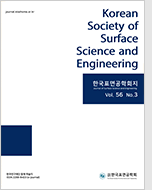
- Past Issues
- e-Submission
-

2021 Impact Factor 1.766
5-Year Impact Factor 1.674
Editorial Office
- +82-2-563-0935
- +82-2-558-2230
- submission@kssse.or.kr
- https://www.kssse.or.kr/

2021 Impact Factor 1.766
5-Year Impact Factor 1.674
The Korean Society of Surface Science and Engineering 2023;56(4):233-242. Published online: Aug, 30, 2023
DOI : https://doi.org/10.5695/JSSE.2023.56.4.233
In recent years, energy-management studies in buildings have proven useful for energy savings. Typically, during heating and cooling, the energy from a given building is lost through its windows. Generally, to block the entry of ultraviolet (UV) and infrared (IR) rays, thin films of deposited metals or metal oxides are used, and the blocking of UV and IR rays by these thin films depends on the materials deposited on them. Therefore, by controlling the thicknesses and densities of the thin films, improving the transmittance of visible light and the blocking of heat rays such as UV and IR may be possible. Such improvements can be realized not only by changing the two-dimensional thin films but also by altering the zero-dimensional (0-D) nanostructures deposited on the films. In this study, 0-D nanoparticles were synthesized using a sol –gel procedure. The synthesized nanoparticles were deposited as deep coatings on polymer and glass substrates. Through spectral analysis in the UV–visible (vis) region, thin-film layers of deposited zinc oxide nanoparticles blocked >95 % of UV rays. For high transmittance in the visible-light region and low transmittance in the IR and UV regions, hybrid multiple layers of silica nanoparticles, zinc oxide particles, and fluorine-doped tin oxide nanoparticles were formed on glass and polymer substrates. Spectrophotometry in the UV–vis–near-IR regions revealed that the substrates prevented heat loss well. The glass and polymer substrates achieved transmittance values of 80 % in the visible-light region, 50 % to 60 % in the IR region, and 90 % in the UV region.
Keywords Suppressed thermal conductivity; Nanoparticles; Zinc oxide; Fluorine-doped tin oxide; Deep coating.